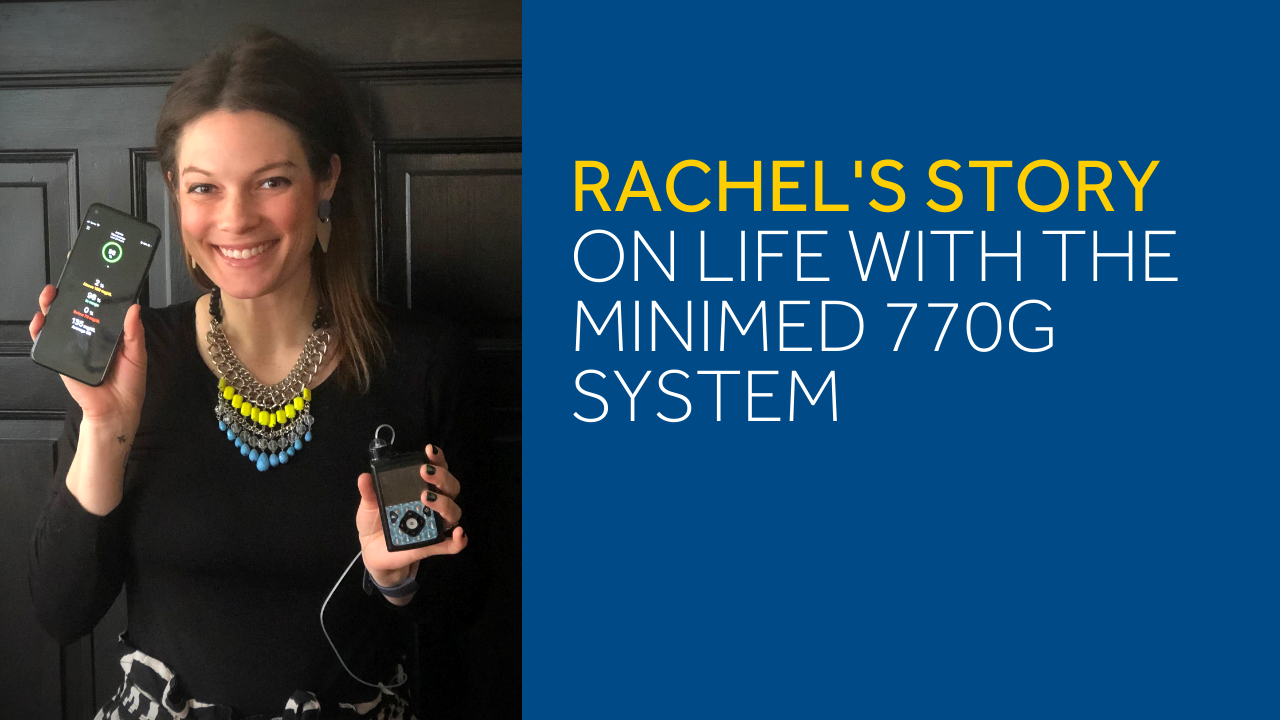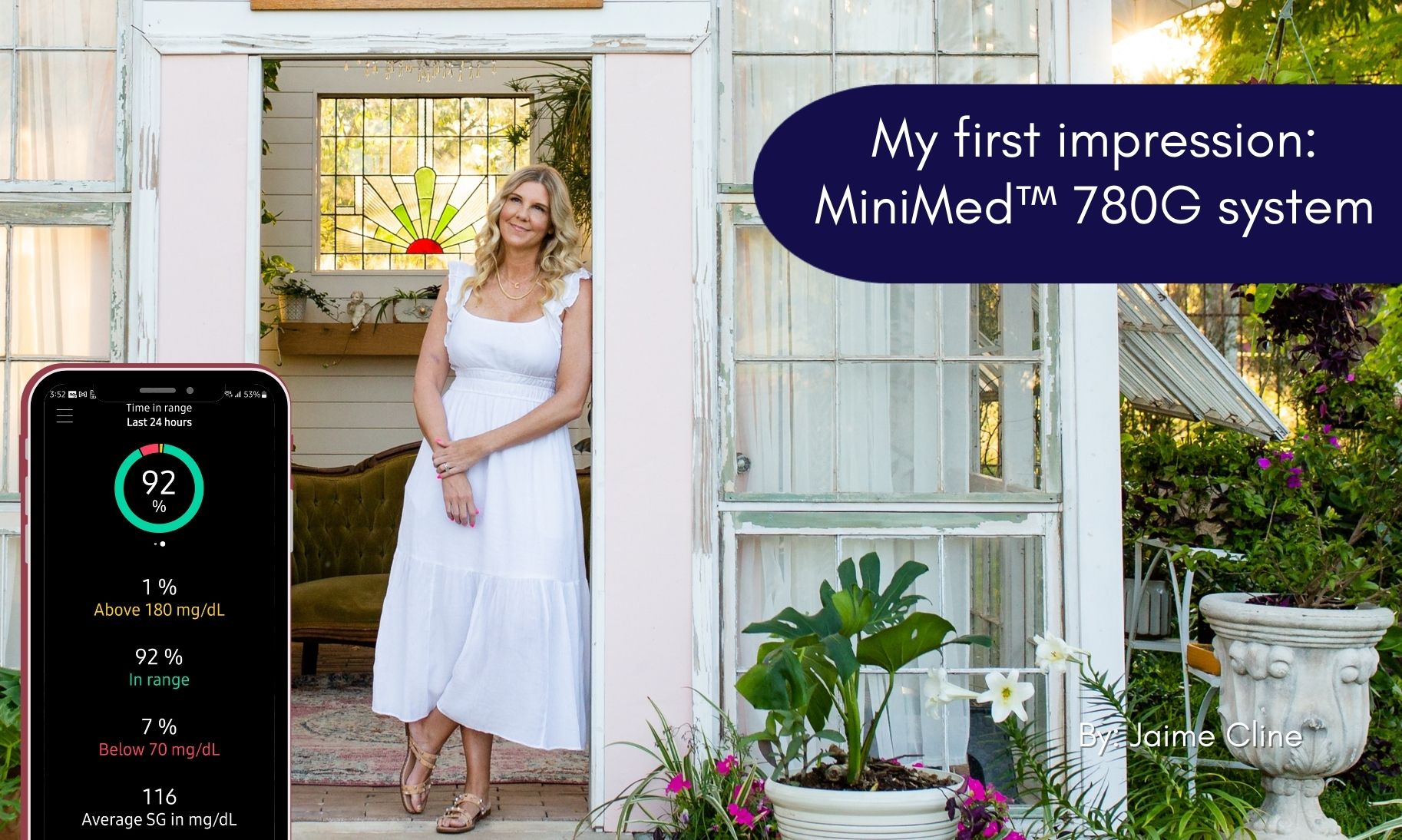Getting started with the MiniMed 770G system: Rachel's story

Today, we’d like to introduce you to, Medtronic Ambassador, Rachel, who recently started using the MiniMedTM 770G system. Hear from her on how having her diabetes information at her fingertips has made an impact on her life.
Let me set the scene. I’m at a business dinner wearing a casual, black, one-piece dress. Like most other times I’ve worn a dress, my insulin pump is placed front and center on my bra. It’s a discreet location and most people don’t even know it’s there. As I’m sitting there chatting with some colleagues, I hear the first beeps coming from my pump. I think, “I’ll ignore it for now. No one noticed.” The second round of beeps sound, but this time, it catches the attention of some of the others around me. I reach down my dress and pull out my pump to check the alert, only to see the wide, questioning eyes of those around me. “Rachel, is that your phone?” I reply with a chuckle, “Oh, didn’t you know? I’m a robot!” With even more surprised looks now, I continue, “It’s actually my insulin pump alerting me that my glucose is rising.” All attention is on me as I clear the alert from the pump, then proceed to check my blood sugar for an evening calibration and before-meal bolus.
To some, this may not seem like a big deal or even worth talking about. But, for a person living with diabetes, there seems to be an ongoing cycle of needing to be discreet in so many everyday situations. I don’t want to disrupt what is going on around me, whether it’s a dinner, a meeting, or even a simple one-on-one conversation. Are there settings to silence your pump and the alarms? Yes. But, do I always remember to turn them on beforehand? Of course not.
That’s how the Medtronic MiniMedTM 770G system came to the rescue. When I first heard about a pump and transmitter equipped with Bluetooth, I was intrigued and needed to know more. After doing some research and hearing more about it, I decided to upgrade from my current system and give the new system a whirl.
In order to fully utilize the Bluetooth capabilities, I downloaded the MiniMedTM Mobile app onto my phone. Who knew a phone app would eventually become so handy for diabetes? By simply opening the app, I’m greeted with a screen that not only displays my current glucose, but also shows my trends for the past 24 hours as well. I can see when I gave myself insulin, when I checked my blood sugar, and the automatic insulin delivery that SmartGuardTM Auto Mode is controlling—all WITHOUT having to pull my pump from the depths of my outfit. Having this information at my fingertips makes it so much easier to plan and prepare for everyday activities such as working out and eating. But wait, there’s more. With one swipe to the left, I can see my Time in Range (the percentage of time my glucose is between 70-180 mg/dL). I’m also able to see my percent above and below range, along with my average glucose level. For those who are visual learners, a graph is provided on the same screen displaying similar information.
In the Settings section of the app, I can have my data automatically uploaded to CareLinkTM software, which compiles the information into different reports that can easily be viewed by my endocrinologist so I can be provided with the best care possible.
And still, it gets even better. There’s also an option for those close to you to become “care partners.” By downloading the CareLinkTM Connect app on their phone, they are able to see the highs and lows of your diabetes right along with you. Who would have thought that receiving texts from your mom saying, “You’re low, go eat something!” or “Your glucose is trending upward, go run a lap around the block!” would be so comforting and reassuring that you’re not alone in this journey?!
These benefits of smartphone connectivity bring the story full circle. I was recently sitting in a virtual staff meeting when I saw an alert pop up on my phone. I let out a sigh of relief knowing that I had control of my diabetes without having to disrupt the meeting. I did not have to immediately fumble for my pump, I did not need a corny joke to segue into my diabetes spiel, and I could keep my focus on the meeting without taking immediate action.
I applaud Medtronic for this new technology that provides people with a more convenient way to keep their diabetes in check. I’m grateful for those few extra moments during the day when I don’t have to dive deep for my pump, knowing that diabetes management is right at my fingertips. The testimonial is of an individual’s experience using a Medtronic device. Talk to your doctor about your health and the risks and benefits of Medtronic devices.
IMPORTANT SAFETY INFORMATION: MINIMED™ 770G SYSTEM WITH SMARTGUARD™ TECHNOLOGY
The MiniMed™ 770G system is intended for continuous delivery of basal insulin (at user selectable rates) and administration of insulin boluses (in user selectable amounts) for the management of type 1 diabetes mellitus in persons two years of age and older requiring insulin as well as for the continuous monitoring and trending of glucose levels in the fluid under the skin. The MiniMed™ 770G system includes SmartGuard™ technology, which can be programmed to automatically adjust delivery of basal insulin based on continuous glucose monitoring (CGM) sensor glucose (SG) values and can suspend delivery of insulin when the SG value falls below or is predicted to fall below predefined threshold values.
The Medtronic MiniMed™ 770G system consists of the following devices: MiniMed™ 770G insulin pump, the Guardian™ Link (3) transmitter, the Guardian™ Sensor (3), one-press serter, the Accu-Chek® Guide Link blood glucose meter, and the Accu-Chek® Guide test strips. The system requires a prescription.
The Guardian™ Sensor (3) has not been evaluated and is not intended to be used directly for making therapy adjustments, but rather to provide an indication of when a fingerstick may be required. All therapy adjustments should be based on measurements obtained using a blood glucose meter and not on values provided by the Guardian™ Sensor (3).
All therapy adjustments should be based on measurements obtained using the Accu-Chek® Guide Link blood glucose meter and not on values provided by the Guardian™ Sensor (3). Always check the pump display to ensure the glucose result shown agrees with the glucose results shown on the Accu-Chek® Guide Link blood glucose meter. Do not calibrate your CGM device or calculate a bolus using a blood glucose meter result taken from an Alternative Site. It is not recommended to calibrate your CGM device when sensor or blood glucose values are changing rapidly, e.g., following a meal or physical exercise.
WARNING: Do not use the SmartGuard™ Auto Mode for people who require less than 8 units or more than 250 units of total daily insulin per day. A total daily dose of at least 8 units, but no more than 250 units, is required to operate in SmartGuard™ Auto Mode. |



